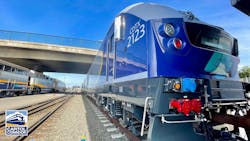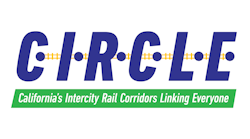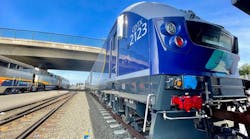Capitol Corridor to achieve goal of running fleet on renewable diesel by end of May 2023
Capitol Corridor and San Joaquins intercity rail services are set to achieve their goal of running their entire fleets on renewable diesel (RD) by the end of May 2023. The transition will begin on May 8 at the Oakland Maintenance Facility when the renewable diesel tank is slated for delivery.
“The successful testing of renewable diesel to run locomotives was spearheaded by Capitol Corridor, and as a result, intercity passenger rail services throughout California will soon run on cleaner fuel,” Capitol Corridor Joint Powers Authority (CCJPA) Chair Robert Raburn said. “The project was a collaborative effort of statewide partners committed to advance California’s goal of zero-emissions."
RD is chemically similar to fossil diesel but made from renewable raw materials such as used cooking oil, not crude oil. Because RD is produced by utilizing the already existing carbon stored in the renewable raw materials in nature, when the fuel is combusted, the carbon dioxide it emits is not considered as harmful as adding new carbon to the atmosphere.
The use of fossil diesel releases new carbon dioxide and other greenhouse gases, contributing to climate change. Other emissions, such as fine particulates and nitrogen oxides, may also be reduced through the use of renewable diesel, which improves local air quality.
State and federal partners collaborate to find new fuel source for California passenger rail
“CCJPA initiated the exploration of alternative fuel options in collaboration with the California Air Resources Board (CARB),” Robert Padgette, CCJPA managing director said. “The California State Transportation Agency (CalSTA) stepped up to fund the testing and worked with the passenger rail equipment manufacturers to ensure the efficacy of the new fuel source. CalSTA also worked with the U.S. Environmental Protection Agency to obtain official certification."
Transitioning from polluting fuels to a more sustainable option is aimed to reduce a fleet’s environmental impact, but it is an effort that takes technical expertise funding, as well as regional and federal oversight. To protect public health, the EPA has stringent standards to reduce fine particles and other harmful emissions from locomotive engines, as well as the fuel trains use.
California Intercity Passenger Rail services team up for cleaner air
Other rail services will soon fuel their entire fleets with RD.
“Switching to renewable diesel has been a strategic initiative for the San Joaquins,” said Brian Schmidt, director of equipment services at the San Joaquin Joint Powers Authority (SJJPA) said. “SJJPA would like to thank CCJPA for its leadership in converting our shared fleet to renewable diesel. Our collective commitment to reducing greenhouse gas emissions has taken a large step forward.”
”As we implement on our climate commitment, we welcome new ways to support Amtrak trains in California – including the 170-mile long Capitol Corridor route,” said Jeanne Cantu, Amtrak vice president, California. “We are thrilled that the pilot’s success allows us to operate on renewable diesel resulting in fewer lifecycle emissions throughout California.”
Testing partnership showcases the potential for rail industry to swap to renewable diesel
CCJPA, worked with Amtrak to successfully complete testing of Neste MY RD in August 2022. RD certification followed in November 2022. Neste MY RD is fully compatible with all diesel engines and current diesel fuel distribution infrastructure, so Capitol Corridor did not need any extra investments or modifications to make the switch.
“We are thrilled to help Capitol Corridor complete the testing of Neste MY Renewable Diesel in their locomotive,” says Carrie Song, vice president, Americas from Renewable Road Transportation business unit at Neste. “Renewable diesel is a solution available already today to reduce GHG emissions from all diesel engines. This testing showcases the potential of using renewable diesel to combat climate change for the rail industry.”





